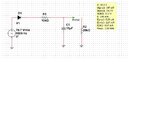sh-eda
Member level 1
Hi,
I wonder if someone could tell me if there is a formula I can use to work out what the DC voltage / average voltage will be in the circuit.
(A half way rectifier connected to resistor divider, and a smoothing capacitor on the output of a divider)
I think I should be able to work it out, or derive it, but I've forgotten how to do it and but it seems more complicated that it looks.
Maybe its really simple, but I know it's not as simple as Vpk/pi.
Appreciate any help
Thanks
- - - Updated - - -
Sorry I think I have posted this in the wrong forum..
I wonder if someone could tell me if there is a formula I can use to work out what the DC voltage / average voltage will be in the circuit.
(A half way rectifier connected to resistor divider, and a smoothing capacitor on the output of a divider)
I think I should be able to work it out, or derive it, but I've forgotten how to do it and but it seems more complicated that it looks.
Maybe its really simple, but I know it's not as simple as Vpk/pi.
Appreciate any help
Thanks
- - - Updated - - -
Sorry I think I have posted this in the wrong forum..
